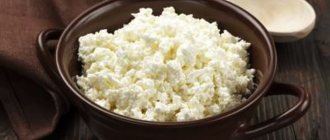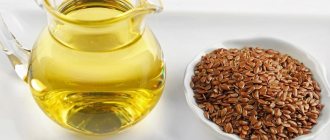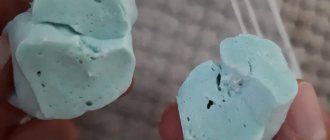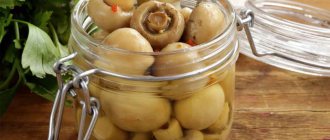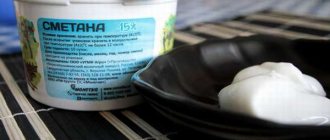What is required for salting
When using heat treatment, you need to prepare fresh cucumbers, preferably only from the garden on the same day. Usually they use “Rodnichko” and “Nezhinskie”. They should be evenly colored and have a thick peel.
They are placed in distilled or spring water to soak for 2 - 12 hours so that all the bitterness goes away. If there is a lot of chlorine in the water, then running water will not work.
Place the cucumbers in sterilized jars. An opened jar should only be kept for up to 3 days.
How and where to store pickles
In the apartment
Cucumbers are pickled in different ways, but there are some that are suitable for residents of high-rise buildings. It will be possible to use them for two years.
You can put it on a balcony, loggia, or on a shelf in a closet. The main thing is that the place is free from sunlight and there are no heating devices nearby.
On the balcony, loggia
If these rooms are glazed and insulated, then this is an ideal place to store workpieces. Only the racks must be closed.
In the cellar
These are the best places to store preserves. Basic condition:
Appropriate temperature and ventilation.
Walls and ceilings treated against harmful microorganisms using special means.
Safety of various workpieces
Jars of pickled cucumbers last 2 years in cellars, a little less in apartments.
Canned twists are stored in apartments for about 3 years.
Pickled cucumbers require certain indicators: temperature and humidity, so that the brine does not turn sour. Usually such pickles are rolled into 1 liter. jars.
How can you tell if your pickles have gone bad?
Pickles lose their crunchy texture over time, but even without it they can still be edible. So how can you tell if your pickles have gone bad? A few signs that indicate a spoiled pickle include a domed jar lid, mold, or black or brown growth on the pickle.
- Check the pickle jar: If the lid of the pickle jar is not flat, but rather has a swollen, domed shape, the contents may have gone bad. This may be due to the jar not being sealed properly. Also check for brown or black growths in the jar. It could be a fungus.
- Just by looking at the brine: You can use your senses to identify a spoiled marinade. If you see a slimy, discolored liquid or the brine appears thickened, it has gone bad. Spoiled pickles do not look bright and become slimy. There may be mold or mildew in the brine.
- By the smell and taste of the brine: Pickles smell sour, but if they give off an unpleasant odor, it's time to throw out the jar. If looking at the pickle and smelling it doesn't help, you can taste it.
If it tastes bad, throw it away immediately. If your brine is homemade, label it. This will help you correct its composition or storage methods in the future.
How to store lightly salted cucumbers
It has accelerated pickling, so it can stand only from 1 week to 1.5 if the cucumbers are large. The gherkins should be eaten within 2 days. The brine requires cold water. Store the pickling in cellars or refrigerators.
There is no need to cut off the ends of the cucumbers. It is better to prepare this pickling in disposable bags and store for 1 to 3 days on the refrigerator shelf.
To increase the period, you need to prepare a mixture with 1 glass of hot water, 1 tbsp. l. salt, mix everything. Add 1 tsp. ketchup or tomato paste, 0.5 tsp. paprika and 5 cloves of garlic, it must be chopped. Stir everything until smooth and pour into the brine.
Salting cucumbers
The requirements for pickling cucumbers are the highest.
It is important that the fruits have enough sugar for complete fermentation, which means they must be at the optimal stage of ripeness. Overgrown ones will be soft due to insufficient production of lactic acid.
According to GOST, short-fruited cucumbers with a diameter of up to 5.5 cm and a length of up to 11 cm are considered first-class for industrial canning. Group II cucumbers can have a length of up to 14 cm. If you like smaller cucumbers, you can also pickle gherkins 5–9 cm long, but the concentration of the brine for they are reduced (40–50 g of salt per 1 liter of water versus 50–70 g for ordinary cucumbers).
It is easier to determine the optimal stage of ripeness for cucumbers with black spikes on large tubercles: when they outgrow, they quickly turn yellow and signal that they are no longer suitable for pickling. But those with white spikes can maintain a deceptively decent appearance for a long time.
Traditionally, the best pickled cucumber is considered to be the one with the pimpled “Russian shirt”: the bumpy surface has a larger area of contact with the brine. But this nuance is more important for quick pickling, and with the usual method, any fruit will have time to be well saturated with salt and the aroma of spices.
Rules for storing pickled cucumbers in barrels
The cucumbers are pickled in such a container, and then transferred to another container with lids and sent to the refrigerator shelves.
It is advisable to season the vegetables with mustard and other spices to improve the taste and prevent mold. With sufficient attention to the brine, such cucumbers will last up to 1 year.
Cucumbers are placed in barrels. And there they ferment. For fermentation, brine is made, which after a while begins to ferment. The temperature scale where the barrels are located does not exceed 0 - 1 degree. These indicators cannot exist in an apartment.
Barrel products with a short shelf life. Bacteria develop and the composition of the brine changes. If cucumbers stand for a long time, they lose their shape and taste.
If fresh mushrooms become moldy. Similar:
You shouldn’t be afraid of mold, it’s not that scary and the situation can be corrected with salted mushrooms. But if the pickled ones are moldy, then they should be thrown away immediately. If the mold is only on top, then you should remove the top layer of mushrooms and drain the entire solution, then rinse all the mushrooms with running water and bring them to a boil in a new salt solution, and then put them in clean sterilized jars. You can add spices and seasonings again. Mold may appear due to a broken salting technology process. There could be rows of jars, or little salt or a small amount of brine was put in. If mold has penetrated deep into the jar, then it is better to throw away the mushrooms.
To be honest, they salt the milk mushrooms, knowing for sure that the top layer will become moldy). This has been going on since ancient times. Therefore, none of the housewives are even upset about this. Many people cover the container where the milk mushrooms are salted with a clean rag, and then remove it along with the mold. Others simply remove the top layer of mushrooms along with herbs (dill, bay leaf, horseradish leaf). The brine is drained and the mushrooms are washed. Sometimes they are boiled again for a few minutes (I don’t boil them). They try and determine what is missing, salt? And then the mushrooms are put back into a clean container with new additions of herbs, garlic, and so on. The milk mushrooms are salted in an open container; there is no need to worry about botulism.
Throw everything away immediately! Mold is very dangerous. It releases a neurotoxin that is very dangerous to the body. The fact is that mold is a fungal microorganism. When it becomes visible to the naked eye, it means there is already a catastrophic amount of it and such a product must be thrown away immediately. And while it was not visible, it was already there anyway, but it could only be detected with the help of laboratory analysis. And this means that the mushrooms are completely spoiled. Where it seems that there is no mold, in fact it is there, but it is still invisible to the eye. Think about your health - people get poisoned by mushrooms anyway, and moldy ones are generally terrible.
In my opinion, mushrooms, even milk mushrooms, even salted ones, are not such a valuable product that you would endanger your health and the health of your loved ones in order to save it. Yes, there are different types of mold, there is even healthy and tasty mold (just remember Roquefort cheese), but how do we, ordinary citizens without the appropriate laboratory equipment, know what kind of mold has grown on mushrooms, and what toxin or something else, it’s like is it producing now? Mold on food is a lottery, and most often a losing one, so I never listen to those people who in such cases repeat: “But this mold is nothing terrible. I’ve done this a hundred times - and nothing!” For me, any mold - this representative of a separate kingdom (neither an animal nor a plant), always poses a danger, no matter in what form and no matter what color and smell it is.
Top articles: Engine oil expiration date -
They probably didn't have enough salt, but that's okay. Salted mushrooms can always be washed under running water and consumed safely. Remove the mold from the top, rinse, add salt if necessary. And rinse or sterilize the container in which they will be stored very well.
I love salted milk mushrooms with sour cream and onions. In the mushroom year, we salt them in huge quantities. Yes, from time to time we have to observe a situation where mold forms on the surface of the jar, which of course is upsetting. There are several reasons for the appearance of mold, namely: – non-compliance with the cooking technology (lack of salt, lack of moisture); – dirty dishes in which mushrooms were prepared and stored; - the mushrooms were not washed and cleaned well enough. Mold on the surface of the jar is not dangerous. It appears as a result of the interaction of the air inside the can and the humid environment. Tik mushrooms can be eaten, but the mold must first be removed along with the top layer of mushrooms and discarded. Mushrooms should be rinsed under cold water before use. Even better, before closing the jar, place a cotton cloth on top, which will absorb the juice of the mushrooms as well as mold. When you open the jar, the cloth is removed and in most cases, there will be no mold on the mushrooms themselves. If mold has affected the entire jar, then this is a sign that microbes and dirt have entered the jar and all the mushrooms are infected with it. Such a jar, no matter how much you would like it, will have to be thrown away because... Eating such mushrooms is extremely dangerous.
Storage time for pickled cucumbers
The shelf life depends on various indicators:
- twisting methods;
- premises with their conditions;
- containers.
In closed jars
They use different methods for twisting. Consume within 12 months. It is possible to leave more, just check that fungus and infection do not appear.
In open jars
Cans should not sit in refrigerators for a long time. They quickly become infected with fungi. They usually last up to 2 weeks. If they do not become cloudy or moldy, then the product is good.
How long can canned cucumbers last?
There is a difference between the shelf life of home-canned and store-bought canned goods. Cucumbers purchased at the supermarket can be stored for three years, but if they contain little vinegar, the three-year period is reduced to two years. When buying store-bought cucumbers, compare the release date with the current date - it is better not to eat last year’s preserved cucumbers.
Never buy a bulging jar of canned cucumbers - they are extremely dangerous to your health.
It is advisable to use canned homemade cucumbers within a year, since during long-term storage they lose many useful substances and become less safe for the body. Home preserves can develop botulinum toxin, which causes poisoning, often leading to death.
How many people are sent pickled vegetables by grandmothers, aunties and relatives from villages? If you doubt the quality of the resulting preparation, boil the cucumbers for 10-15 minutes - all the toxic substances in them will be destroyed under the influence of high temperatures.






